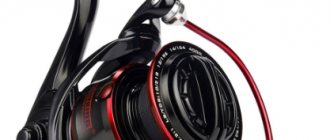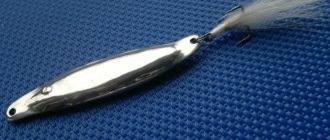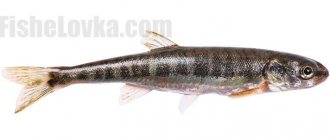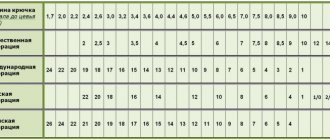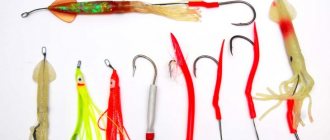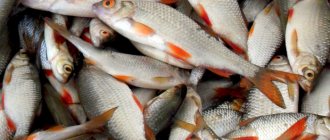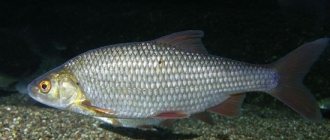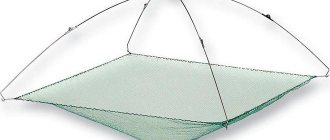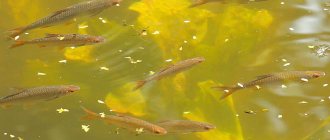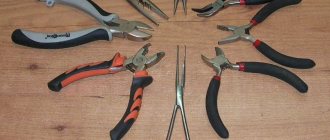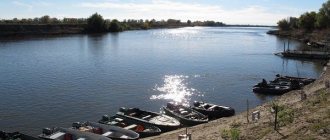Fishing terms
Avon, or Avon, is the name of a float designed for fishing in the river. It has a thick and long keel and a very short antenna. This design stabilizes the float in flowing water.
Aggressive retrieving is a much more intense action of the bait than is used every day at this fishing spot. This bait causes a strong vibration in the water, which is felt from afar and causes an aggressive attack from the predator.
The action (action) of a rod is the depth and resistance of the rod when bending under load. Instead of the word "share" the word "flexibility" is often used.
Alga is a legendary Polish spinner produced by Polsping. In its work it imitates a roach. Effective for catching pike, pike perch and perch using spinning and trolling methods.
Dampening fish jerks - softening sudden movements of fish for its survival and to avoid line breakage. The jerks of the fish are absorbed by the rod, the rubber connection or reel brake, the fishing line and the hands of the fisherman himself.
Antikinker (anti-twist) - a small plate to prevent the line from twisting. It is placed on a fishing line with a light bait and without a sinker.
Balsa is a tropical tree that is used to make floats. In recent years, they have been made from genetically modified balsa, so a cracked float does not absorb water.
Barbus is a small relative of the barbel from the carp family.
Bathymetry - studying the bottom topography and plotting the results on a map. A very useful map for the fisherman.
Bombarda is a loaded “sbirulino” float with a ribbed shape and great buoyancy. It is often used for bait fishing.
A beard (or bird's nest) is a skein of fishing line or braid that is tangled into a ball.
White fish (bel) is a calm-biting fish, not predatory.
White worm (maggot) – fly larva; used as groundbait and bait.
Spinner is an artificial fishing bait; there is oscillating and rotating.
Goby – bighead, “granny”, goby – the name of a special family of fish.
A barb is a notch, a notch on a fishing hook that prevents fish from slipping off the hook.
Swamp boots - above-the-knee rubber boots; used by fishermen when they need to stand in the water for a long time.
Brovka is a sharp change in depth near the shore.
Backing is a winding on the spool of a reel, usually from fishing line, located under the main (working) fishing line.
A bathhouse is a deep washed bottom in a mountain or foothill river.
Banner (flag) – dorsal fin of grayling. The large fin of a large grayling is often taken as a trophy.
Emergence is a short phase of transformation of a larva into an insect.
B is a symbol that indicates the action of the rod, or flexibility. This is a very important parameter of the fishing rod.
A spinner is a rotating spoon, a type of spinning bait for catching predatory fish. The luring role is primarily played by a petal rotating around an axis, which causes vibrations in the water, attracting fish of various species. A very effective bait also for non-predatory fish.
Depth gauge - a lead weight on a fishing line to determine the depth at the fishing site.
The eye is a multi-valued concept in fishing: circles that diverge on the surface of the water at the moment the insect is captured by the fish; wire loop in the float and hook, jig head and numerous fishing knots; a small area free of plants in an overgrown pond.
A sinker is an element of fishing rod equipment, used in a variety of fishing methods. The main types of sinkers: point, separate, center, side. The materials for the sinker are: lead, tin, modern paste with the consistency of plasticine, stone (as a sinker for a bottom fishing rod).
Devon is a spinning artificial bait, small and heavy, suitable for fishing in the current and in the bottom layer.
Dendrobena is a type of earthworm developed in California in the 1950s and is a live bait.
Detritus is a product of the breakdown of animal and plant matter found in the water column and on the shore.
A jig is a head and a fairly large hook, soldered into a round lead sinker. Designed for attaching artificial rubber or rooster baits.
Dip is an attractant concentrate in liquid or powder form. Serves to flavor the bait before casting.
Donka - bottom tackle. Implies the presence of a heavy load at the end of the tackle.
Track - fishing from a floating boat with a spoon that moves behind the stern.
Drift is free movement with the current and wind. Refers to bait and boat.
A quivering tip (quiver tip) is a type of bite alarm in bottom fishing, which is a flexible, sensitive rod tip that responds to the pull of the fish by bending.
Ironweed is a worm up to 15 cm long, used as bait.
The sting is the point of a hook.
Live bait is a small fish placed on a hook as bait for catching predatory fish.
Fish protection - can be complete or partial, its purpose is to protect a given population or species. In fishing, the protective size, fishing period and permissible number of fish caught per day are most often used. The protection of fish is regulated by relevant law.
Protective area - in relation to fishing, this is the name of a strictly defined territory in which a fishing ban is in effect. Most often these are spawning grounds, nurseries for fry, etc.
Zakidushka is a casting fishing rod, similar to a donka, with a feeder at the end of the tackle.
A yawn is a device for removing a hook, which allows you to open the mouth of a fish wide and keep it in this state.
Notching - adjusting the notching by repeated movement.
A school is a permanent or periodic gathering of fish, for example during feeding or spawning migration. Many fish species live in schools only when they are young.
Bite is the moment when the fish takes the bait; often divided into the moment of tasting and the moment of swallowing the bait.
Casting is a sport related to fishing. It is based on exercises on the technique of handling fishing tackle: casting a weight from various distances for accuracy, casting a weight and a fly at a distance, etc.
Edge – The side of a boat or a straight and high bank under which a stream flows.
Kukan is a device for storing large fish alive, made of a metal chain or a strong cord with large carabiners.
Flounder is a common name among fishermen for fish belonging to the flounder family and found in the Baltic Sea: ruffed fish, river and sea flounder.
Littoral zone is a coastal zone in a lake or in the sea, in reservoirs.
Lapot is a large fish (bream, crucian carp, etc.).
Fishing is the general definition of fishing.
The blade is the end of the hook shank. There are hooks with a blade, an eye, a ring, and very rarely without any finishing. Each type of hook attaches to the line differently; Suitable fastening points must be used.
Salmonidae is a family of fish in the order Salmonidae; among fishermen they are often called noble. These include salmon, brown trout, brook trout, Danube salmon, whitefish, vendace and grayling.
Atlantic salmon - found in the Atlantic Ocean, Europe and North America. The largest specimens caught in Norway weighed about 36 kg.
Underwater meadow is a bottom area covered with submerged vegetation, usually low and often of the same type. It performs at different depths from 1.5 m to 3 m, as well as on shallow slides. This is a very fishy place, but technically very difficult to fish.
Lupine is a plant of the legume family, suitable for multi-day feeding of carp, bream, crucian carp and tench.
A match fishing rod is a fishing rod for float fishing for fish located several tens of meters from the angler’s position. This fishing method is often called the long-cast method. It requires the use of special accessories. Very effective for catching white fish and some predators.
Small fish is the general name for fry and small fish in a school.
Wet flies are artificial baits that imitate drowned adult insects, as well as aquatic larvae. Used for underwater wiring.
The bloodworm, the larva of the mosquito mosquito, living under water, is a natural food for many species of fish, and therefore an excellent bait at any time of the year. Unfortunately, this is a very delicate, fragile bait, difficult to store and transport, and also expensive. However, the effectiveness of the bloodworm compensates for the costs and difficulties of handling it.
Breakwater/breakwater - a structure to protect a port, part of the coast or a strategic object from the destructive effects of waves. Can be made of metal, concrete or wood. On the border with deeper water it is an ideal place for catching fish of many species.
Mini bait is a spinning silicone bait of the smallest sizes such as twister, ripper, worm. Perch is caught at different depths with a mini-bait, as well as bream, rudd, roach, and ide. In order to use the mini-bait competently and effectively, use a side leash on a rod with a super-soft tip.
Extension (knee) – an additional part of the rod; overlapped to increase casting distance.
Spawning flow - a massive movement of fish to spawn, up the river. In this case, fish of the same species move on a short section of a river or a small surface of a lake.
Fly fishing is fishing with a spinning rod by casting a long braided line with a light floating bait (artificial or animal origin). Fishing is carried out in the upper layers of water.
Fishing is the methodical throwing of gear with bait into the area where fish are supposed to be located in a body of water.
A release is a device for releasing hooks and lures when they are caught on underwater snags and stones, consisting of a long rope or fishing line with a heavy weight tied to it in the shape of a steering wheel.
A branch is a branch of a river (channel), partially cut off from the main channel.
Landing net, landing net - a mesh bag tied to a rim mounted on the handle. Used to remove hooked fish from the water.
Front edge – difference from shallows to depth; back - from depth to shallow.
A food chain is a relationship in which the organisms of the subsequent link eat the organisms of the previous one. In a natural ecosystem, undisturbed by humans, each organism is an important link in the food chain of many other organisms. The exclusion of at least one link causes serious disturbances in the balance of the ecosystem and in the food chain, that is, in a group of organisms dependent on each other. For example, removing pike from a lake causes an excessive increase in bream, cod and crucian carp, which then become smaller and become sick en masse.
pH is an indicator of the acidity or alkalinity of water (liquid). This characteristic of water is the main one that influences the life of fish in a given water area, as well as the development of animals and plants. There are simple ways to determine the pH of water in a pond; indicator tests can be purchased at an aquarium store.
Parr is a young one-year-old salmon up to 21 cm long.
Paternoster is one of the oldest types of feeder rod equipment, designed for fishing with dead and live fish. Effective in both running and standing water.
Pellet – granules; originally used as food for animals, including fish. After changing the composition, it became a convenient and widely used bait and groundbait. Currently, various types of pellets are produced, designed to catch certain types of fish and fish of a certain size. Most often, pellets are used in combination with hair attachment.
Pearl barley is a barley grain that is readily used as bait or a very effective bait for white fish. Cheap and easy to process.
A picker is a rod with a sensitive tip and light weight of equipment; it can be equipped with a set of tips. Picker presents a version of a very light rod called a quivertip, it is used for catching roach and other small fish. With such light tackle they catch without a feeder.
The swim bladder is an internal organ of fish that performs several important functions. Damage to the bladder makes the fish incapable of life.
Rubber is an artificial bait made of soft plastic.
The caddisfly is an order of insects with complete metamorphosis, with exclusively aquatic larvae. Caddisfly larva is an excellent bait, as it is a common food for fish in many reservoirs.
A sliding float is a part of a floating rig for long casting that signals when a fish is biting. Protection from overlaps and the release depth of the float, which moves freely along the fishing line, are regulated by two rubber stoppers.
Dry flies are richly feathered artificial baits used for skimming along the surface of the water.
Rapids is a place in a river where the current is especially rough and swift. Typical for mountain and semi-mountain rivers with a rocky bottom.
Tabletop is the part of the flat bottom in a lake or river where fish stop. This is an excellent fishing spot.
A teardrop is a type of sinker shaped like a teardrop. Has a central hole for pulling fishing line. Modern teardrops have a PVC tube in the hole, which protects the thin fishing line from damage.
Connector - a rod element used to connect elements. This role is played by a ring, a clip, a clasp, a swivel, a special carabiner - a clasp in the fly tackle for the float, as well as loops on the fishing line and special knots for connecting two fishing lines.
Composite – this is the name given to both a wobbler made of two or three parts, and a protective or combined carp leash made from materials of varying hardness. The leash makes the tackle more elastic, which allows you to outsmart the fish by better simulating live prey.
Fingerlings are the autumn fry of brook trout and pike perch. Fingerlings raised in fish ponds are used for stocking wild waters.
The dough is a thick mass mixed with one or more components, such as bread, buns, potatoes, semolina, etc. The dough is used to catch calm zhora fish.
The shadow of the current is a clearly defined slowdown in the current behind an obstacle, for example, behind a fallen trunk, boulder, sandbank, or spit arrow. This is a good place for catching predatory fish.
Tulka is a small sea fish of the herring family, used both live and frozen for catching predatory fish (usually pike perch or burbot). Used as bait for girders or as a bait for vertical lures.
Tyrolean stick is a type of final weight used in spinning and bottom fishing. It is used for long-distance casting and keeps a light bait suspended near the bottom. It has an elongated shape (which largely avoids snags) and has a certain buoyancy. The Tyrolean stick is a sealed plastic tube, one end of which is attached to the equipment, and the other has a weight.
The rod is the main part of the fishing rod, usually a long flexible stick. A rod without tackle and without a reel handle is said to be unarmed.
A rowlock is an element for fastening oars on board a boat.
Fashina - young and flexible branches of a vine, knitted into plaits, used in the construction of fortifications, such as a dam, a bandage, a dike. Most often it serves as a mattress on which stones are laid. The river often destroys such a structure, exposing the fascine, which attracts fish. Good fishing spot.
Phenol is a substance that is widely used in the chemical industry. It has a bad reputation because, when it enters with wastewater, it often causes mass death of river fish.
Phenology (phenologist's calendar) is a science that studies the seasonal development of the nature of plants and animals (phyto-phenology and zoophenology), due to the change of seasons and changes in climatic conditions. A phenologist's calendar has been developed for fishermen, taking into account the developmental phases of river plants and fish behavior, primarily spawning. Plant development is mainly stimulated by air temperature and amount of water, and fish behavior is mainly stimulated by temperature and water level.
Fermentation is the process of anaerobic enzymatic transformations of chemicals. For a fisherman, this is of great importance: fermented bait is not suitable for use; leaving a large amount of poorly prepared bait in the water causes it to ferment, which scares off the fish and poisons the water. Potatoes and pasta are the most susceptible to fermentation.
Feeder (from the English “feed” - to feed) is a bottom fishing rod with a vibrating tip, designed for fishing with a feeder. Available in various weight versions, taking into account casting and adaptation for fishing in slow and fast flowing rivers.
Fillet is usually a flat piece that is cut from a fish carcass and is used as an effective bait for pike perch, catfish, pike, asp, burbot, eel, and sea bass. Chub, river carp and bream are also caught on small fillets - most often in winter and during the pre-spawning period.
Fluorescent paint - glows when exposed to external light: light, flashlight, etc. This paint is usually coated with baits and fishing rod tips. The weak light emitted from the surface of the bait attracts fish.
Fuchsin is a dye with a wide range of applications, often used to dye white maggots red. A synthetic analogue of fuchsin was developed in 1858 by the Pole Jakub Natanson. It was one of the first synthetic dyes in the world.
Fatso is a very effective and world-famous Polish wobbler from Salmo. Used for spinning and trolling.
Floating (from English “floating”) - floating attachments for a spinning rod and a floating fly line according to the AFTM classification system.
FS is an abbreviation for the English term fast sinking. Detects fast-sinking fly line in the AFTM system.
Tail (spawning flow) - a mass movement of fish to spawn, for example, up a river. In this case, fish of the same species move on a short section of a river or a small surface of a lake.
Whiplash is empty fishing, casting a fishing rod without results.
The tail is a bunch of synthetic or natural material that is attached to the keel or hook of an artificial bait, usually to a spinner. It can play a different role: attract by sight or smell, signal the location of the bait.
Whip is the colloquial name for a light, short fishing rod.
Grip is the quality of the hook. The hook has good grip and easily and reliably penetrates the fish's mouth when hooking. The quality depends on the hook manufacturers.
Cicada is a type of spinning bait.
Cheburashka is a type of lead sinker: usually round in shape with two rings located at some distance from each other. It is usually used for fishing when fishing with foam fish.
Scales are an element of fish skin that covers its outside; found in most fish. Most often it plays a protective role for the skin. In the course of evolution, fish have adapted their scales to their way of life - for example, catfish have no scales at all, and tench have small scales deeply hidden in the skin.
Eutrophication is a process of biological productivity of water basins caused by nutrients that accelerate the development of aquatic plants. As a result of their rapid development, life in reservoirs dies, elements enter the water, the bottom becomes muddy and often covered with peat. This is a long process and it is very difficult to repair the damage. The most common elements are agricultural fertilizers and improper treatment of municipal wastewater.
Ecology is a science that studies the interdependence, interrelation and interaction of living organisms (with each other and with the environment).
An ecosystem is a selected fragment of nature that functions as a single whole, and the living organisms of fauna and flora located in it and their biotope are closely related to each other.
Eccentric sinker - a sinker with an asymmetrical center of gravity; it is hooked in front of the bait, and thanks to this, twisting of the fishing line is eliminated while retrieving the bait.
Elodea is a group of perennial aquatic herbs; in some species only flowers are visible. This group includes, in particular, Canadian elodea and submerged hornwort.
An endemic species is a living organism that has a small, relatively limited range. This is due to the evolution of an organism that is significantly isolated from other biotypes, or with its high specialization. This species is found only in this specific place in order to survive.
Epilimnion is the top layer of water in a lake. In summer, the layer into which light penetrates more is warm and rich in oxygen. The division of the water column into thermal layers is called thermal stratification.
Erosion is the washing away and carrying away of soil near the shore into a river or lake. As a result of erosion, landslides form, high banks disappear, fragments of soil and rocks fall into the water and breaks form on the asphalt surface of roads. Hilly and mountainous areas devoid of forests are most susceptible to erosion. River banks are subject to excessive and catastrophic erosion as a result of cutting down riverine trees.
Fishing ethics is a set of norms, usually called “fair play,” that fishermen observe voluntarily. They also concern the handling of live fish. These rules develop, disappear and new ones appear related to the development of fishing and fishing culture. It happens that a fisherman lives in accordance with the rules, but violates ethics when fishing.
Ethology is the science that studies animal behavior.
Ephemerids are a group of insects whose adults live from several hours to several days without taking food during this time. This is egg laying time. A species known to fishermen is the mayfly.
An echo sounder is a device for fishing on long-distance sea vessels, which, using ultrasound, recognizes the shape of the bottom, depth, location of fish and underwater shallows. A high-quality echo sounder allows you to follow fast-swimming fish and works with GPS.
Eska/eska/ – a type of spinner, curved in the shape of the Latin letter S.
Fisherman's Dictionary - fishing terms and their meaning
Without a fishing dictionary, it is very difficult, and often impossible, to understand the “language” of avid fishermen, especially for beginners. Along with the basics of fishing, learning terminology is an integral part of learning to fish.
Taken together, all this knowledge is the ABC of a novice fisherman, without which the hobby of fishing, be it a hobby, amateur or sport fishing, makes no sense.
To quickly search through text, press the keyboard key combination Ctrl-F and enter the search word or term in the window that appears.
So, in fact, the fisherman’s dictionary itself, Russian and foreign fishing terms.
Granny Mayfly butterfly larva, a popular bait for catching most fish of the carp family. The larva lives in the water column or in burrows on the shore of a reservoir.
Balalaika A winter fishing rod of a special design that allows you to effectively manipulate the action of a jig, creating vibrations with a frequency of up to 300 per minute. It is distinguished by its simplicity, light weight and drop-shaped design. Equipped with a reel, fishing line, whip (nod) and jig.
Balancer Spinner with horizontal suspension. It is distinguished by a swinging game to the side and up from the starting position and back with a single swing of the fishing rod. With a series of successive strokes, the spoon goes far to the side. Used for catching perch, pike perch, and pike from ice.
Benthos The totality of organisms living on the bottom and in the soil of a reservoir. It is divided into animal (zoobenthos) and plant (phytobenthos).
Benthophages Fishes that lead a bottom lifestyle, the main diet of which is benthos (protozoa, larvae, green algae, etc.). Bream, crucian carp, tench, carp, and barbel are typical representatives of benthophages.
Spinner Artificial metal bait. It differs in the nature of movement (play) in water (rotating, oscillating, diving), in shape, structure and weight. Weight is calculated in grams.
Stonefly Light gray butterfly with transparent wings. An adult insect and its yellow-brown larvae are perhaps the only catchable bait in fly fishing in early spring. Butterflies appear along the banks of flowing reservoirs on stones, above-water vegetation, and on coastal dead wood.
Swivel An element of equipment that connects individual parts of the equipment and ensures their free rotation. Prevents twisting of the main line or braid, used to connect bait (spinner, wobbler) with a leash, mainly when catching a predator.
Wobbler
Artificial bulk bait for catching predatory fish (pike, perch, pike perch, etc.). In the water, a wobbler imitates a wounded or fleeing fish. From English wobbler
- stagger, waddle. It is equipped with two or three hooks, differs in the degree of buoyancy into floating, sinking and their varieties.
Crawling Large earthworm. Lives in gardens, vegetable gardens, parks in oily soil. The tail part of the worm is flat and light, the rest of the body is brown. The length of the crawl can reach 10-15 cm.
Depth gauge A device or electronic device for determining the depth of a reservoir at a fishing spot.
Sinker Part of the equipment responsible for loading the tackle, that is, feeding the nozzle to a given depth. They differ in purpose, shape and weight. Sinkers and weights are cast from lead.
Zherlitsa Live bait tackle for catching pike, pike perch, burbot, perch. For summer fishing - a slingshot (flyer) or mugs, for winter fishing - a bet (flags). It is a (flyer, circle, reel) with a wound fishing line, a sinker, a leash if necessary, a tee or a rig with attached live bait. The principle of operation is that the bait is attached to a bush on the shore, on the water (circles) or on the ice above the hole (bet), live bait is attached to the hook and lowered into the water. Usually the fishing rods are set up at night and checked in the morning, although each angler has his own fishing technique. After the bite, they wait until the fish takes the bait well, hook it and land it.
Live bait A small fish placed on a hook as live bait for catching predatory fish: pike, perch, pike perch, burbot and others. They fish with live bait using hooks, mugs, girders, and live bait donks.
Yawner A yawner is a device with the help of which the mouth of a caught predatory fish opens to remove the hook. Made from thick steel wire.
Nod A nod (guard) is an element, mainly of winter reelless fishing tackle, which is a flexible whip at the end of a winter fishing rod (balalaika). A fishing line is passed through the holes in the body of the nod and by its movement (bending) the angler can determine the moment the fish bites (swallowing the jig). The best nods are made of cold-rolled steel or wire, and many homemade options for guards are made of plastic and wire. For better visibility, the nods are painted alternately with bright red and white paint.
Feeders A feeder is a device for throwing bait to the desired point and creating a “feeding table” for effective fishing. Feeders can be open, closed, mesh, or frame. They act as a sinker in gear (donka, feeder) for bottom fishing.
Water Lily The water lily is an aquatic plant with long roots, large leaves that float on the water, similar in appearance to a large green heart, and a large yellow or white flower. The water lily is also called the water lily.
Ice drill A fishing ice drill is a special tool that fishermen use to drill holes in the ice during winter fishing. By design, the ice auger consists of a rotary shaft, an auger and knives. How does it work? With a rotational translational movement around its axis, it “bites” into the ice, forming a cylindrical hole (hole) of a certain diameter (from 70 to 250 mm) with a maximum depth of immersion in the ice of up to 1-1.5 meters. There are manual, electric and motorized ice augers.
line (lines): readprilunk Low water Low water is a long seasonal stand in a river with low water levels. It is believed that during low water the fish bite and catch better than in high water.
Mormysh Mormysh or amphipod is a dark yellow aquatic crustacean. Lives in reservoirs with clean, cold water. Mormysh is obtained by dipping a bundle of hay or straw sprinkled with flour into water for 1-2 hours. They take out and collect crustaceans.
Mormyshka An artificial bait consisting of a metal body of various shapes into which a hook is soldered. There are models with a plastic body. The weight of the jig ranges from 0.1 to 1.5 g. Popular jigs are “pellet”, “drop”, “devil”, “boat”, “uralochka”, “witch”, “goat”.
Bloodworm Bloodworm (raspberry) is a mosquito larva that lives in the mud at the bottom of a reservoir. It looks like a small, mobile “worm” of bright ruby color. Along with maggot, raspberry has been and remains the most popular bait for fishing.
Fly Artificial bait is an imitation of an insect on a hook in all stages of its development (larva, pupa, butterfly) using thread and pieces of fur, wool, feathers, and a variety of synthetic materials. Flies are used primarily for fly fishing. Flies can be wet, dry, nymphs, wingless, single-winged, etc.
Fly A fly is an insect, a favorite bait for bleaks and other fish feeding from the surface of the water. The flies are first caught and placed in a breathable container or box. Place them on the hook, tearing off their wings, 1-2 pieces at a time.
Fly fishing Special equipment for catching fish from the surface of the water, consisting of a rod, reel, cord and “fly” (hook - an imitation of an insect).
Maggot White, often with a yellowish tint, larva of a blue blowfly. The most popular attachment for catching carp fish and predators. The larva holds well on the hook and remains mobile in the water for a long time.
Landing net Landing net (landing net) is a fishing device for extracting large fish from the water. It consists of a structure with a long handle (from 1 to 5 meters) and a ring (triangle) with a diameter of 0.5 cm to 1.0 m, with a bag-like, fine-mesh mesh stretched over it. How to use a landing net - lower it into the water, bring the caught fish into it and remove it from the water.
Floodplain A floodplain is a flooded part of the coastal zone of a reservoir during floods and floods. Floodplains can be river or lake, usually formed in the spring or after long and heavy rains.
Float A float is the most important element of equipment; it signals when a fish is biting. Floats are made of lightweight, water-repellent materials (foam, bird feather, balsa wood, plastic, etc.). When equipping a fishing rod, the float is attached to the fishing line. There are many types of floats for catching different types of fish. Bleak floats are the lightest, do not exceed 0.5-1.0 g. Prilunik Prilunik is a tray cut out with an ice pick and going obliquely into a hole. It is specially cut down by winter roads to pull large fish onto the ice.
Riccia
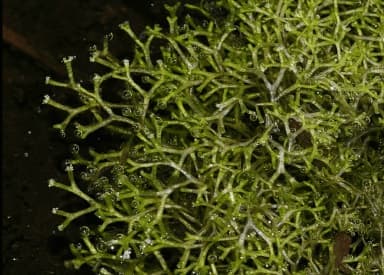
Riccia floating is an aquatic plant of standing reservoirs. It floats near the surface of the coastal zone, has no leaves or roots, and is a plant “tangle” of green flyer stems intertwined. It grows quickly, serves as a spawning ground for some species of fish and a refuge for hatched fry.
Fishing slingshot The fishing slingshot is a classic slingshot for target shooting and is designed for throwing bait to a fishing spot over long distances. Among the design features it is distinguished by soft, elastic rubber and a “glass” for placing a bait ball. You can buy a slingshot at any fishing store or make it yourself.
Fishing hook A fishing hook is an indispensable element of fishing tackle, which is a metal, usually made of hardened wire, L-shaped hook with a barb, onto which the fish directly clings after hooking. Hooks come in various types and sizes.
Fishing line One of the main elements of equipment. In the explanatory dictionary, fishing line is a long, strong thread, one end of which is tied to a fishing rod, and a fishing hook is tied to the other. Modern fishing line is a monofilament or braided line made of high-strength materials. The main characteristic is tensile strength; the stronger it is, the greater the weight of the caught fish. Classification by material, thickness and strength.
Fishing cage The cage is designed to keep caught fish alive in the water. Cages are made from stainless wire woven into a mesh, or from nylon and other durable artificial threads. They differ in single-section and multi-section, as well as in size, length, and purpose. The fish in the cage are in the reservoir and remain alive for a long time.
trap for catching predatory fish from under the ice. It is located above the hole and is equipped with a signaling flag, which, in the event of an attack by a predator, straightens and is visible to the fisherman from afar. A live bait is attached to the stake hook. They mainly catch pike perch and burbot.
Oxbow Oxbow is a section of an old river bed that has turned into a body of standing water. Rivers are known to “wind” and rarely flow straight. Sometimes, during high water, between the bends (at the base of the “loop”) the current washes out the channel and water begins to flow along it, forming a new channel. The entrance and exit to the old channel are gradually covered with sand and silt. This is how old women appear. They are oblong and elongated in shape. Or in the form of a lake, when the area (floodplain) between the old and new channels is flooded. Such lakes are called floodplain lakes.
Twister A silicone artificial bait with a generally ribbed body and a curved “tail” in the shape of a question mark. Used for catching predators: perch, pike, pike perch, etc. on an offset hook or jig head. When retrieving, the tail of the twister vibrates and “plays,” provoking a bite.
Bleak Bleak , bleak, verkhovodka, shakleya, selyava, mulyashka, sintya, etc. - a small, nimble, silver fish of the carp family, inhabiting almost all rivers of the central zone.
Fishing cracker
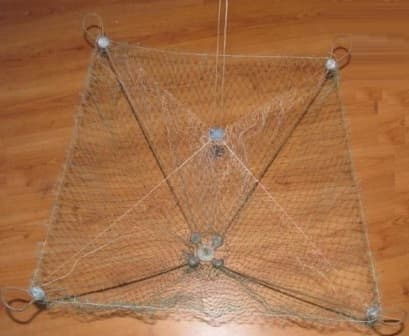
Firecracker, cotton, grabber, umbrella, spider - fishing tackle designed for catching fish from under the ice. The basic principle of fishing is a lift, a folding “spider”. The clapper, when folded, is lowered into the hole and when it hits the bottom, it opens; then, when raised, the cross-shaped guides collapse and, together with the fish that has fallen into the bag from the fishing line, rises through the hole to the surface.
Worm Worm is an animal bait, the most common and popular among fishermen. For fishing, they usually use dung, earthworms, and earthworms (crawlers). An attractive and long-lived bait for catching most fish in our reservoirs. Worms are obtained from the ground, soil, manure, rotten leaves, collected under stones, stumps, stored in jars with soil and holes for air.
Extractor A special tool for removing a hook from the mouth of a predatory or white fish if it has “swallowed” the hook. The extractor allows you to remove the hook without damaging the fish.
Tip Tip (foreign term) - the tip of the form, the thin tip.
